Far from its days as experimental tech, we’re now well into the phase where AI in software development is starting to dominate the mainstream. AI tools are already changing how teams design, test, and ship products, from generating complete UIs out of wireframes to automating regression testing and optimizing deployment pipelines. And these tools are only getting smarter every day.
However, as powerful as AI is, it’s not without its challenges. Outputs, while comprehensive, can lack critical context, and robust security guardrails remain essential across all AI-enabled processes. To truly fulfill its potential, AI needs clear structure, thoughtful oversight, and strong product thinking to guide its use toward real business value.
At Aloa, we help teams establish the clarity, oversight, and intentional design that allow AI to deliver a meaningful impact, whatever your business goals may be. In this guide, we’ll help you sort through the hype, showing you where AI development tools excel, where they struggle, and how you can use them strategically to maximize results.
Let's dive in!
Strategic Guide: How to Integrate AI into Your Software Development Process
AI in software development offers immense potential, but only with a well-thought-out plan of action. Here’s a step-by-step actionable road map to help you start, evaluate, and scale AI initiatives in your organization:
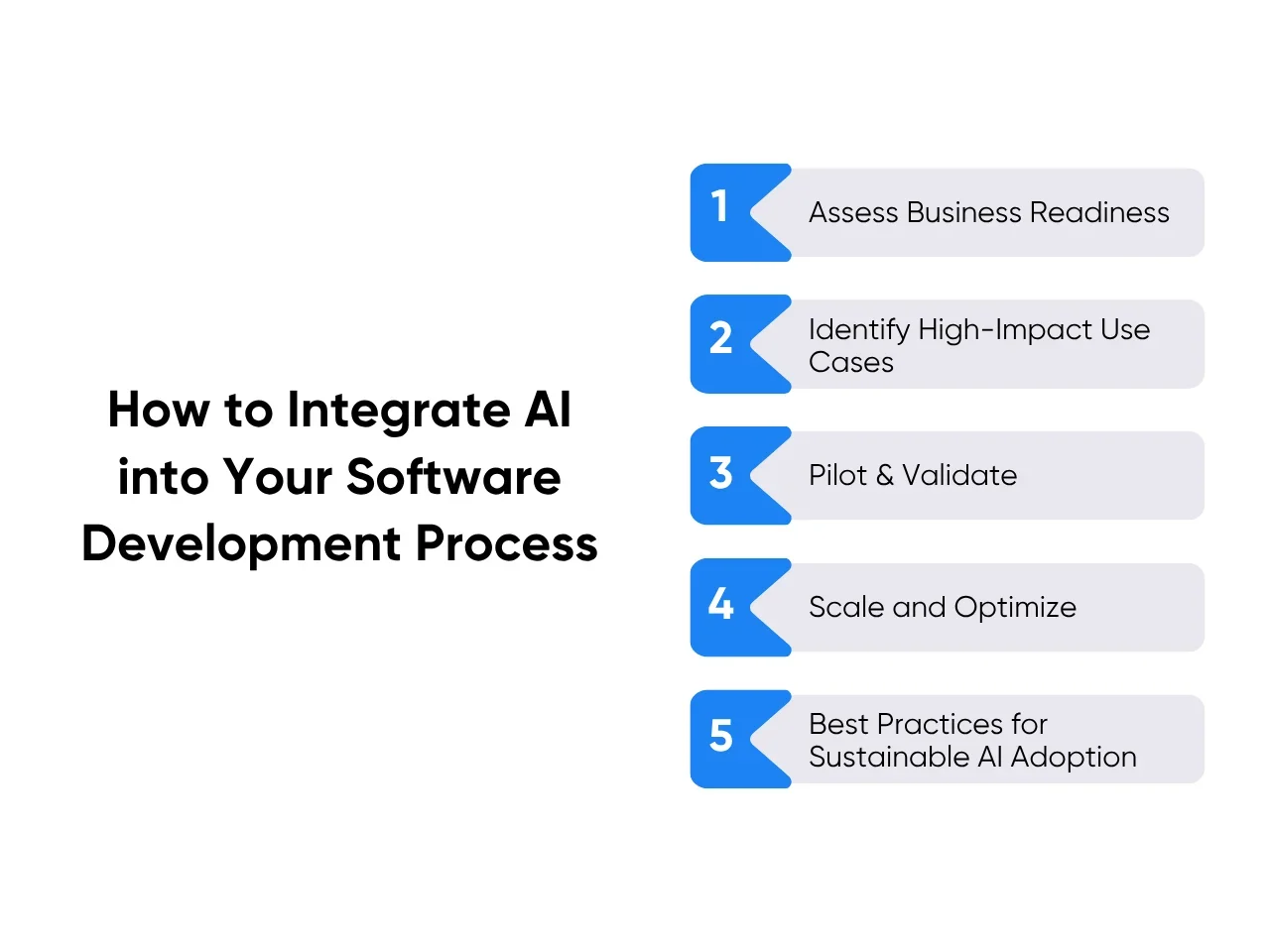
Step 1: Assess Business Readiness
The successful integration of AI revolves around your organization's data infrastructure, individual AI proficiency within teams, and overall strategic alignment. Each of these plays a critical role in determining the effectiveness of AI within your operations.
Investment in robust data governance and infrastructure, prioritizing AI upskilling in key areas, and regular alignment checks all help towards making your business AI-ready.
Step 2: Identify High-Impact Use Cases
At its current stage of development, AI can make the greatest impact by automating repetitive or time-consuming tasks in the software development process. These include first-draft code generation, assisting with routine maintenance, streamlining testing, and accelerating deployment.
Prompt engineering is key here, as precise inputs are essential for achieving useful, context-aware outputs. As is thorough research on specific use cases that may require you to build specific AI tools. Midway through this evaluation, it's also useful to look at how AI is evolving in other domains—such as the rise of the language learning AI chatbot category—which shows how adaptive conversational systems can enhance user engagement and personalize complex workflows. Prioritize use cases that are both feasible and aligned with your broader business strategy.
Step 3: Pilot & Validate
After you’ve identified your use cases, you can start launching small-scale pilot projects in targeted areas of your development workflow to test AI tools in real-world conditions.
Offer your employees training resources like user guides, prompt libraries, and clear examples of what the tool can and cannot do. Usage metrics and pre-mortem sessions to help make sense of them ensure the efficacy of this step.
Step 4: Scale and Optimize
Once AI tools have been validated through successful pilots, the next step is to expand those initiatives across teams and departments.
Build robust infrastructures and cross-functional teams that can interpret and act on AI outputs. Further refinement with the help of data science will ensure that speed, cost, reasoning, and user value aligns as closely as possible with stakeholder expectations.
Best Practices for Sustainable AI Adoption
Sustainable AI adoption hinges on the principle that AI should augment human intelligence, not replace it, and that data and insights should belong to their creators. Companies are expected to be transparent about who trains their AI, what data was used, and how outputs are generated.
Equally important is inclusive upskilling, which puts all members of all teams in the loop to understand how your AI tools work.
Risks and Challenges of AI in Software Development (And How to Mitigate Them)
As a disruptive technology, artificial intelligence in software engineering comes with a wide variety of risks and challenges. Let’s take a deep dive into the ones you might face when integrating AI into your operations.
| Risk | Cause and Effect | Mitigation Strategy |
| AI Model Bias | AI models might have been trained on biased or non-representative data, which can lead to skewed decision-making outputs. This can harm user trust or be the source of legal or ethical dilemmas. | Regular audits, diligent dataset curation, and bias detection tools are key to minimizing the effect of AI model bias. |
| AI Dependency | The ready availability of AI tools can make teams overreliant on them. This can leave them vulnerable when tools fail or produce errors. | Resist the urge to center all workflows around AI. Maintain human capabilities as a fallback and continuously audit where AI-driven software development truly adds value versus where it introduces fragility. This ensures resilience should tools fail or market conditions shift. |
| Security Risks | AI-generated code can introduce security flaws if outputs are accepted without thorough scrutiny or understanding of the underlying risks. | Making it standard protocol to do manual code reviews, security testing, compliance auditing, and automated vulnerability scanning. |
| Lack of Transparency | AI models are often “black boxes”, meaning their inner workings are obscured. This can make it hard to trace bugs, justify decisions, or ensure accountability. | Prioritizing interpretable models and clear documentation to make AI functionality easier to explain. Increasing AI literacy also mitigates the black box effect. |
| Job Displacement and Anxiety | Some roles, especially those involving routine tasks, could face disruption. | Proactive upskilling, restructuring teams around AI-oversight roles, and internal mobility can all help transition staff to more strategic functions that work alongside AI. |
AI’s Impact Across the Software Development Lifecycle (SDLC)
AI stands to rebuild the software development process from the ground up with tools that improve both accuracy and innovation. The following roadmap shows exactly how AI is benefiting each stage of the SDLC.
Requirements and Planning
Gen AI is highly efficient at translating raw ideas into concrete requirements, able to generate test cases, code drafts, and documentation from natural-language descriptions of a desired feature. For example, one of the core design pillars of the Aqua AI copilot is the ability to create a complete, sophisticated requirement from only 15 seconds of description.
As an extra assurance that automated outputs are accurate and reliable, you can employ a narrow pilot at the start and assign a “human-in-the-loop” to expertly vet AI-generated requirements.
Design and Architecture
In the same way that it fast-tracks requirements generation and planning, AI also accelerates the creation of design artifacts, such as high-level diagrams, data models, and architectural decision records, all based on natural-language prompts or requirement documents.
As always, AI tools perform best when they’re considered a starting point rather than a finished blueprint. AI-generated models can produce overly optimistic high-level proposals that may overlook critical aspects like performance under load, system resilience, security limitations, or long-term maintainability. This stresses the significance of human architects to provide expert oversight.
Coding and Implementation
Automation of routine tasks such as boilerplate generation, inline documentation, and basic bug detection is a significant boon for software development workflows. Tools like OpenAI Codex and GitHub Copilot can convert natural-language prompts into functional code, allowing developers to shift focus to higher-order problem-solving. Development teams can also leverage AI-based web app development tools to automate front-end and back-end tasks, improving productivity and overall code quality.
These tools have been proven to accelerate task completion, with GitHub reporting that Copilot users complete assignments up to 55.8% faster. Not only that, they also contributed to an improved developer experience, with at least 60% of Copilot users saying that they feel more fulfilled and able to concentrate on more satisfying work thanks to the assistance of Copilot.
Testing and Quality Assurance
Automation also lends itself well to vital testing and QA tasks such as automated regression testing, test data generation, self‑healing tests, visual regression detection, and exploratory test automation. Platforms like Testim, mabl, and TestRigor use machine learning to generate, maintain, and execute test cases, even adapting in real time to UI or logic changes. This not only boosts efficiency but also increases test depth, often surfacing issues that might be missed through manual methods.
Deployment and Operations
AI-powered assistants and orchestration agents help streamline deployment pipelines, detect anomalies early, and optimize resource usage. This can make them invaluable for accelerating critical tasks such as infrastructure provisioning, code rollout, and real-time system monitoring.
Maintenance and Continuous Improvement
Artificial intelligence in software development also provides benefits to maintenance and continued improvement, mainly focused on data analytics. Tools like SonarQube and CodeScene, for example, assess code health in real time, exposing software quality issues, duplication, or complexity hotspots. The same AI-powered tools also suggest refactors and ways to optimize logic paths.
10 Ways AI is Revolutionizing Software Development
Now, let’s take a more granular look into the specific processes that AI is helping to revolutionize. Here are some key ways AI is facilitating the creation of more sophisticated and efficient software products at a faster pace than ever before.
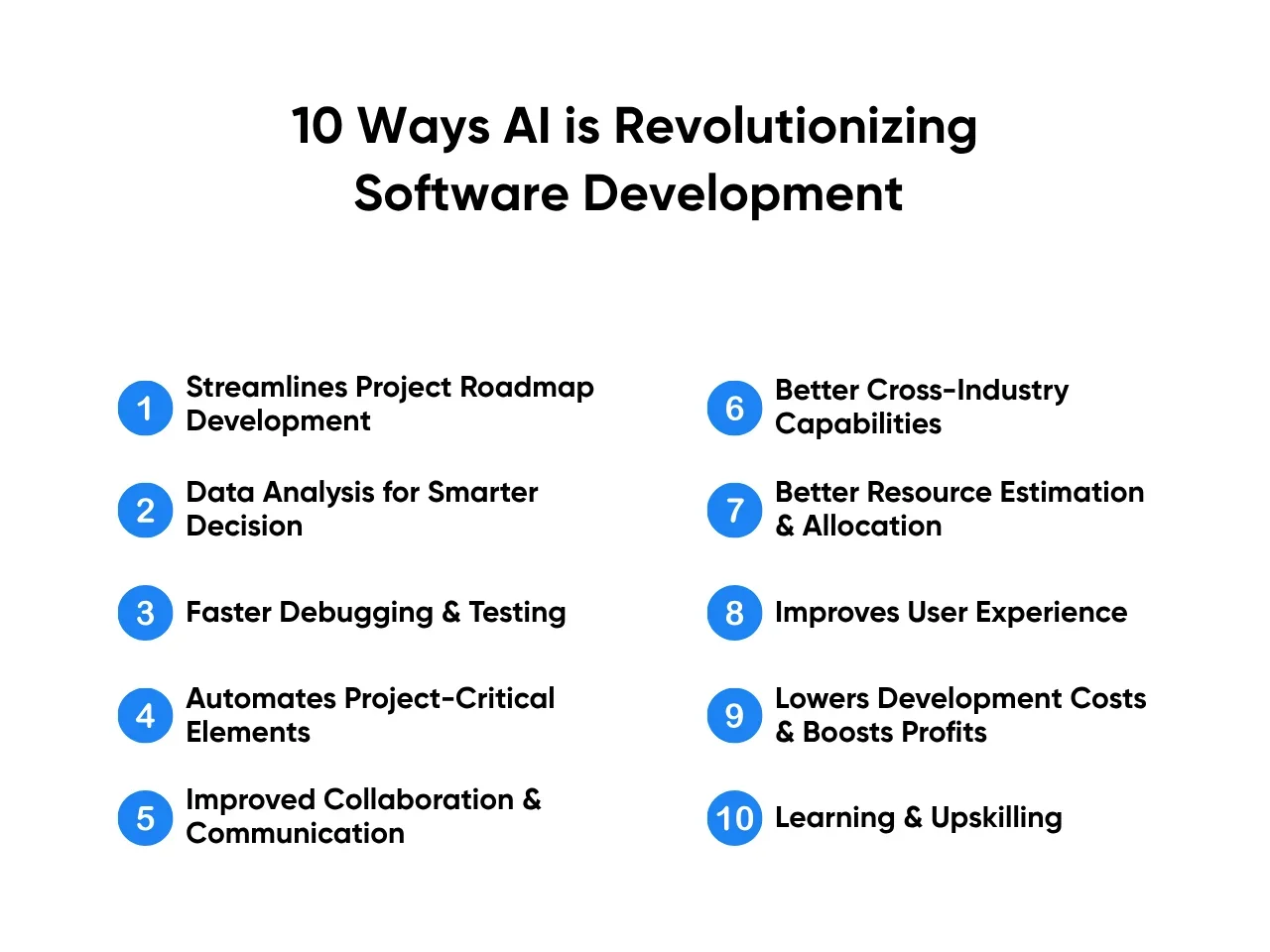
1. Enhances the Project Roadmap Development Process
The benefits of AI in software engineering begin as early as the drawing board, with software developers able to compile and design their project roadmaps using generative AI prompts. Creating organized and appealing project roadmap templates makes it easier for development teams to streamline their client presentations.
Additionally, AI-backed project management systems also allow for real-time identification of risks, roadblocks, and discrepancies, so they can be addressed before they become costly issues. Accolade’s Product Innovation Platform, for example, analyzes market trends and customer feedback to help identify high-value features and foresee technical dependencies or resource conflicts early on.
2. Data Analysis For Better Decision Making
Software development thrives on data-driven decisions. AI gives developers the power to analyze vast volumes of data, from market trends to user feedback, to make informed decisions and build tailored software. This minimizes developing unneeded features and extensive debugging, resulting in higher quality products that truly align with user expectations.
.webp)
3. Faster Debugging and Testing
AI tools significantly accelerate debugging and testing, enabling developers to quickly pinpoint and fix code issues. In a survey conducted by GitHub, 40-47% of respondents said that AI freed them up from debugging and simply trying to make their code functional, allowing them to focus on higher-order tasks such as system and solution design.
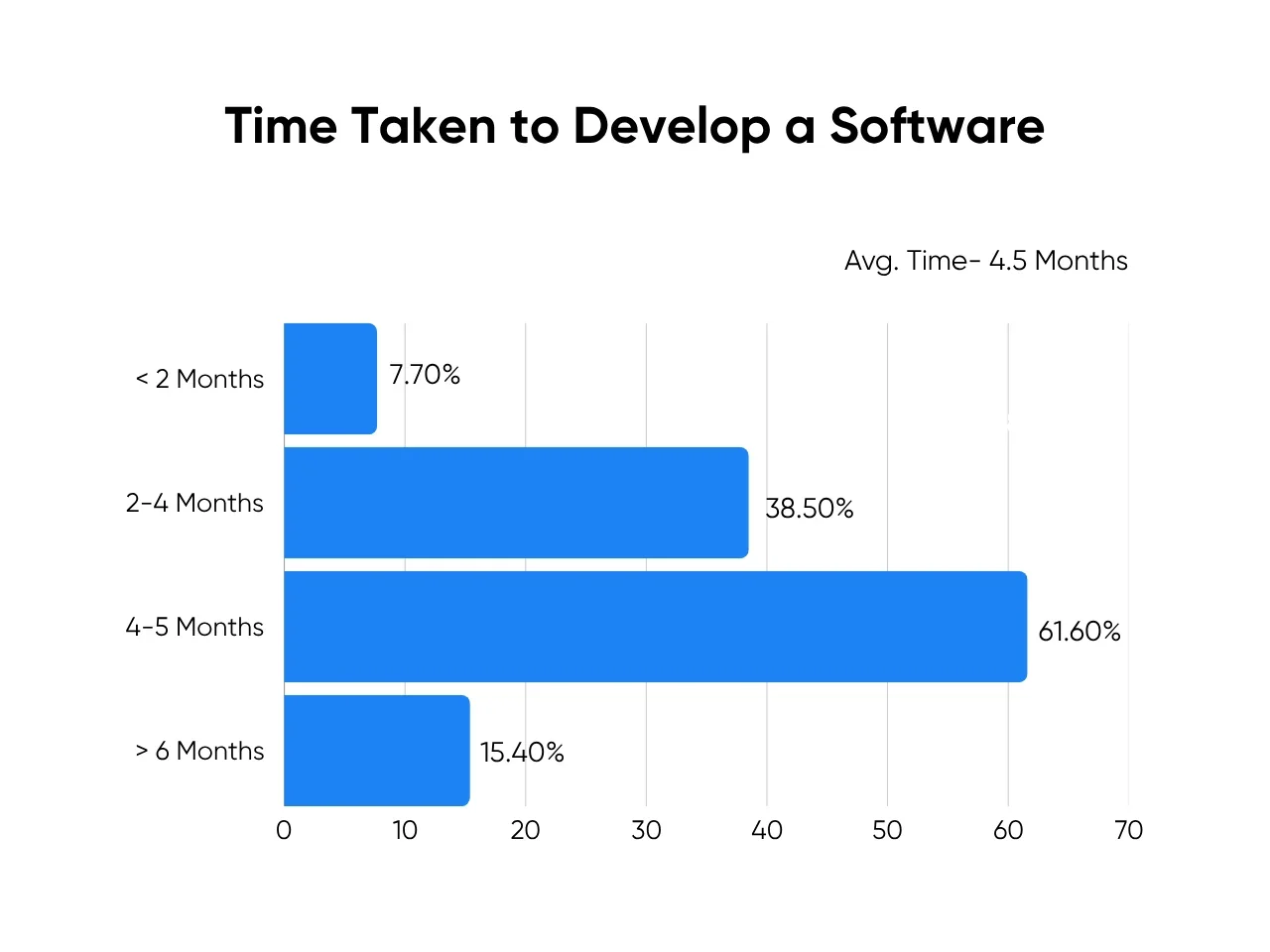
That said, AI hallucinations remain a possibility, stressing the need for a human to double-check critical info.
4. Automates Project-Critical Elements
AI systems streamline project-critical elements, from planning and testing to development, and deployment. Early on in the development cycle, AI-powered testing tool mabl can automatically generate, execute, and maintain a wide variety of self-healing tests, from UI, API, and accessibility.
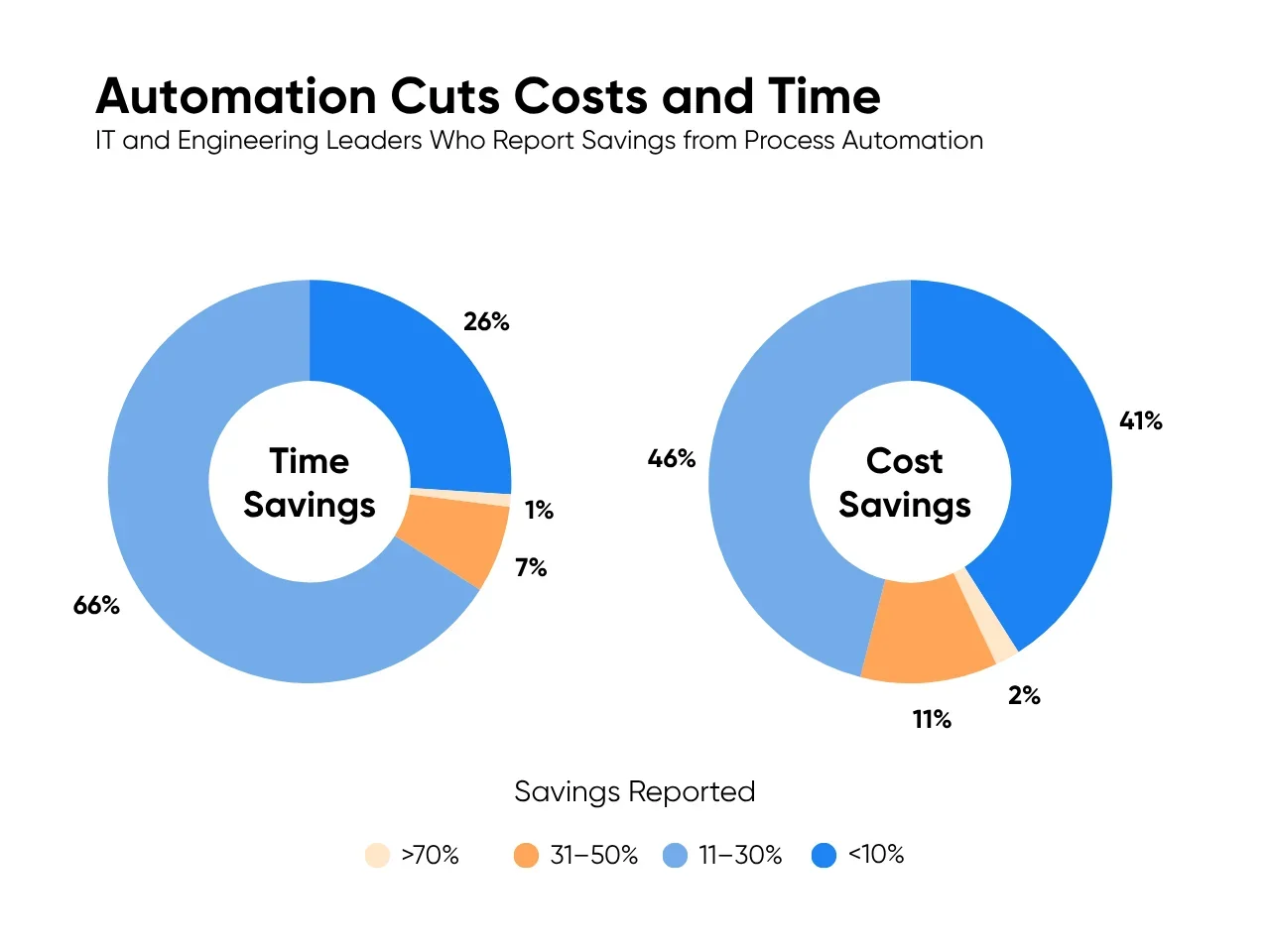
In the development phase, GitHub Copilot can generate code snippets and even entire functions based on natural language prompts, while Digital.ai Deploy automates software deployments across various environments, ensuring fast and secure releases.
5. Improved Collaboration and Communication
AI tools significantly boost collaboration and communication among software developers. They automate communication, offer real-time task insights, and provide a comprehensive overview of project workflow and schedules, highlighting potential delays or bottlenecks.
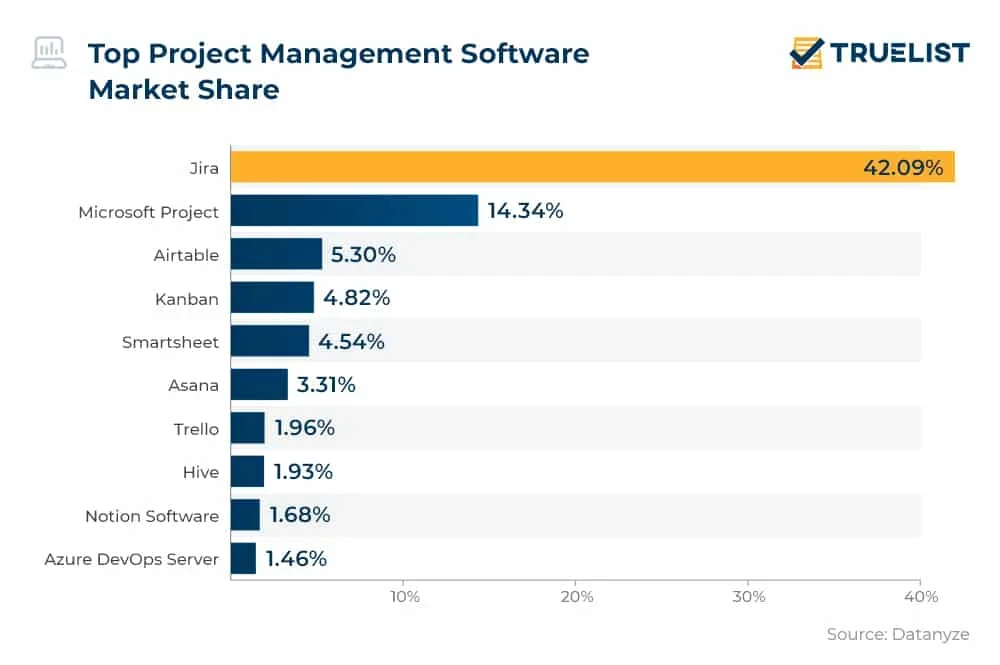
Tools like Asana and ClickUp, for example, centralize progress sharing and updates, streamlining communication. AI also enhances efficiency by using natural language processing to interpret project updates, helping teams track progress quickly and accurately. Coupled with methodologies like Agile, AI-enabled tools ensure organized and efficient project completion.
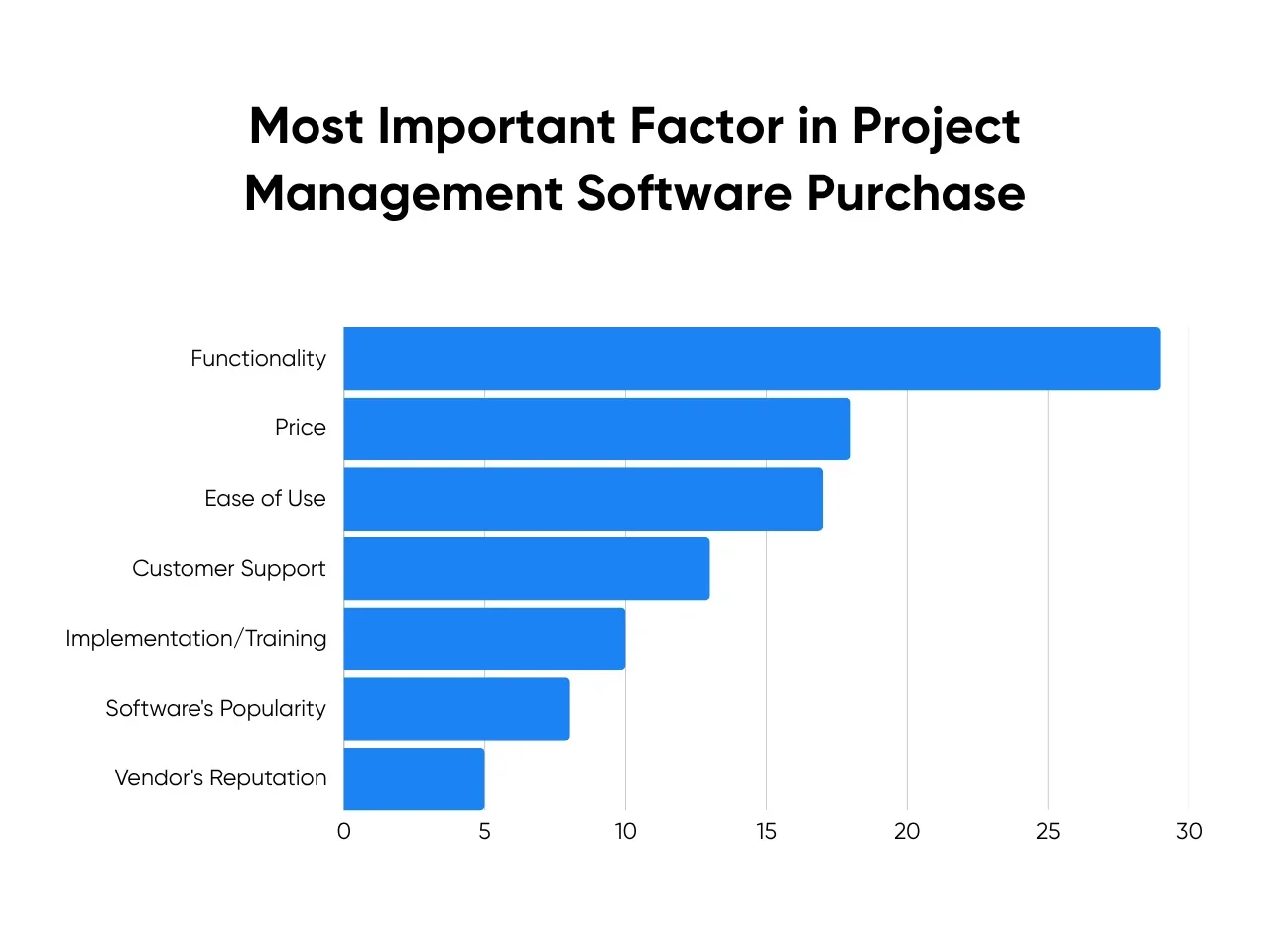
6. Better Cross-Industry Capabilities
AI in software development also helps teams quickly develop more sophisticated products that can be used across industry sectors.
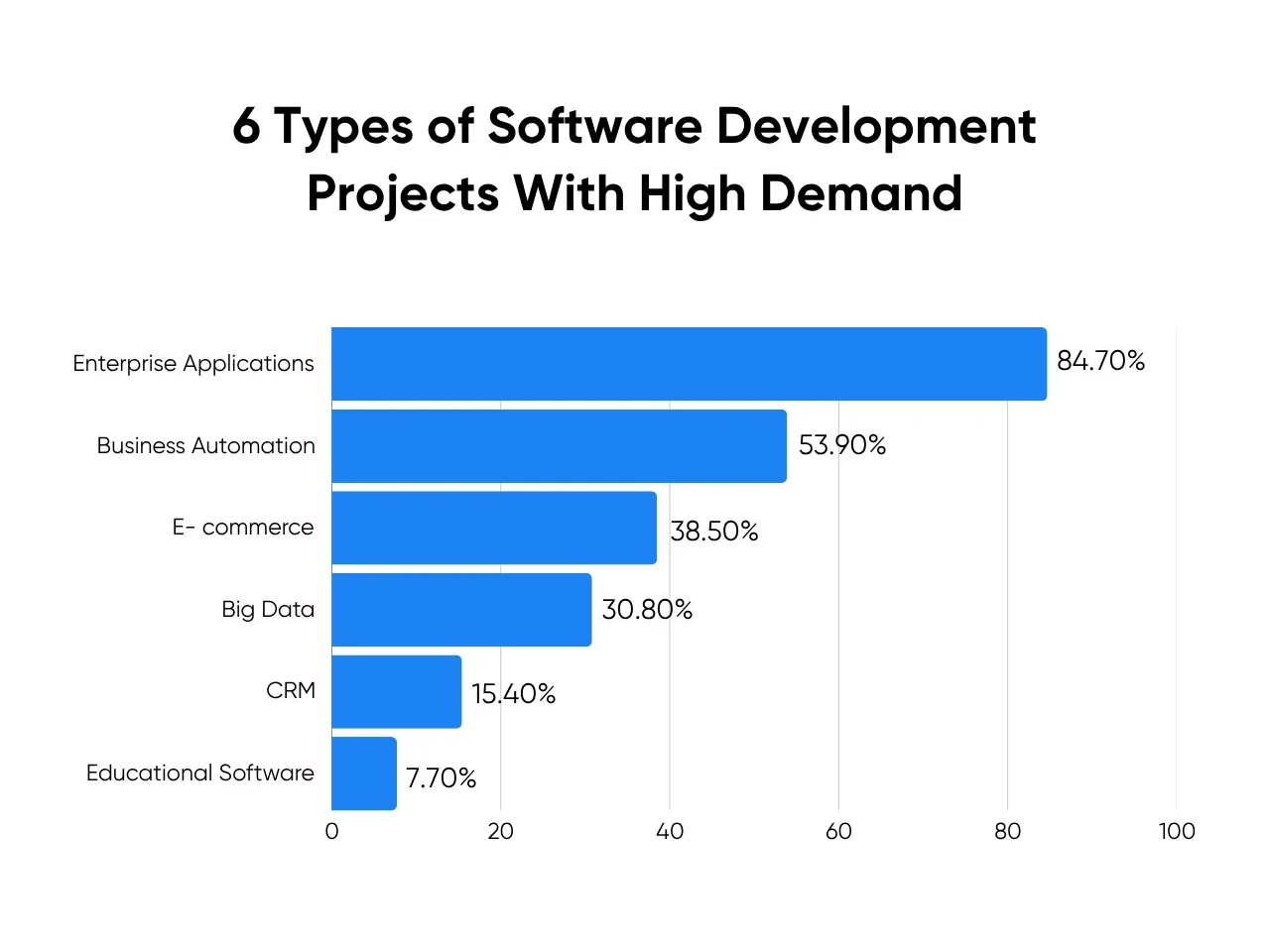
This makes it easier to apply the necessary skills and tools across different sectors, and facilitate seamless integration with existing systems, all providing a significant boost to workflow efficiency in those sectors.
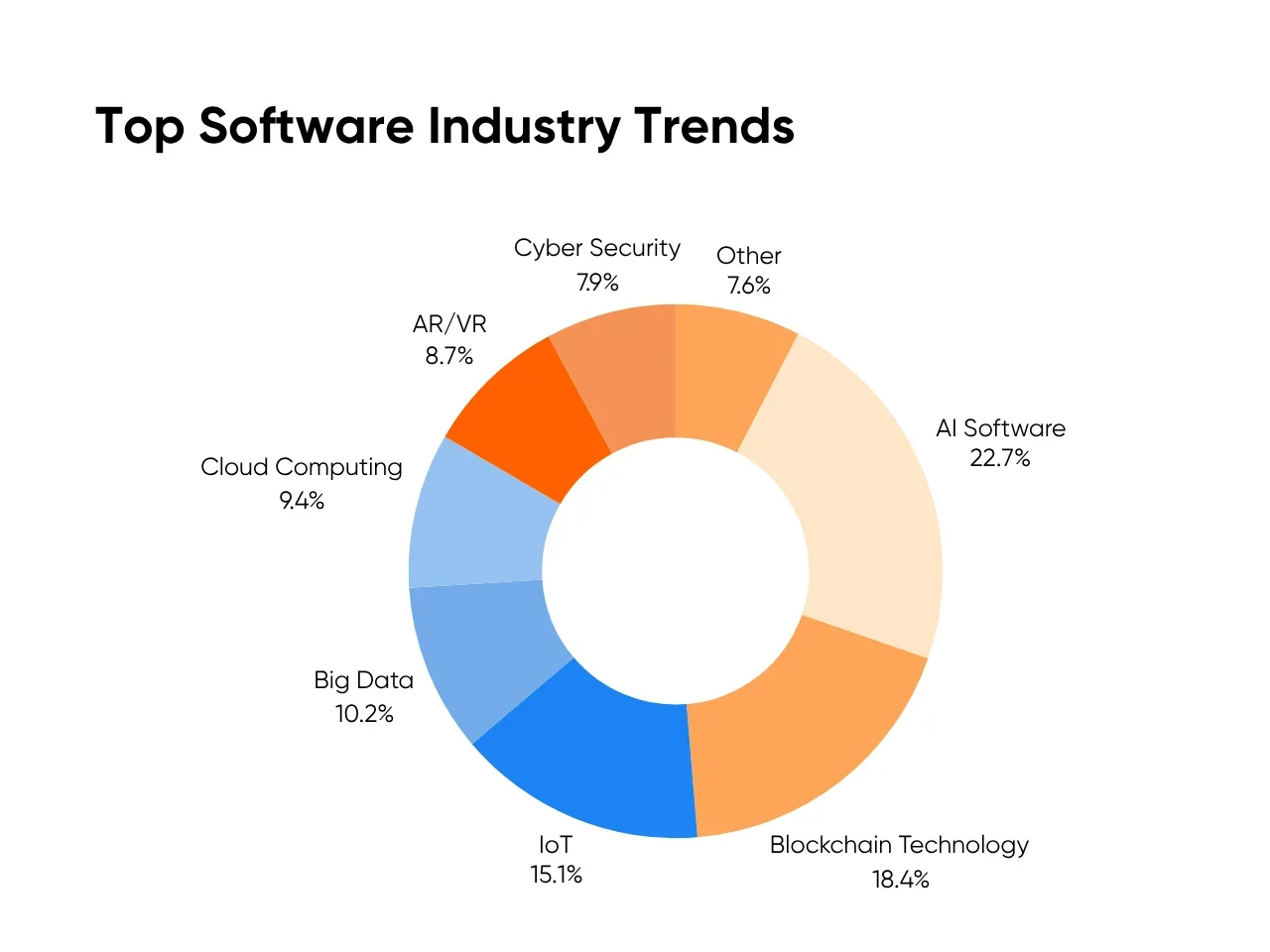
7. Better Resource Estimation and Allocation
AI significantly enhances resource estimation and allocation in software development. AI-enabled tools eliminate inefficiencies and bottlenecks by accurately calculating resource needs and intelligently assigning tasks, boosting project management efficiency.
For instance, a study from the Institute of Public Administration in Saudi Arabia showed that AI-driven decision support systems in Agile environments enhanced workload management by 25%, leading to an 18% improvement in sprint completion rates and overall project efficiency.
8. Improves User Experience
All of the benefits AI provides to all development stages culminates in an improved user experience. The time freed up from repetitive tasks gets redirected towards fueling human creativity, leading to more cohesive and intuitive UX design.
Advanced AI-driven analytics help out here by pinpointing usability issues and suggesting enhancements. AI tools like TensorFlow and PyTorch, for example, help developers design more efficient algorithms that adapt to changing user requirements.
9. Reduces Cost of Development and Increases Your Bottomline
More efficient allocation of time and resources leads to a much lower cost of development, directly contributing to a healthier bottom line and increased profitability by minimizing wasted effort and accelerating time-to-market.
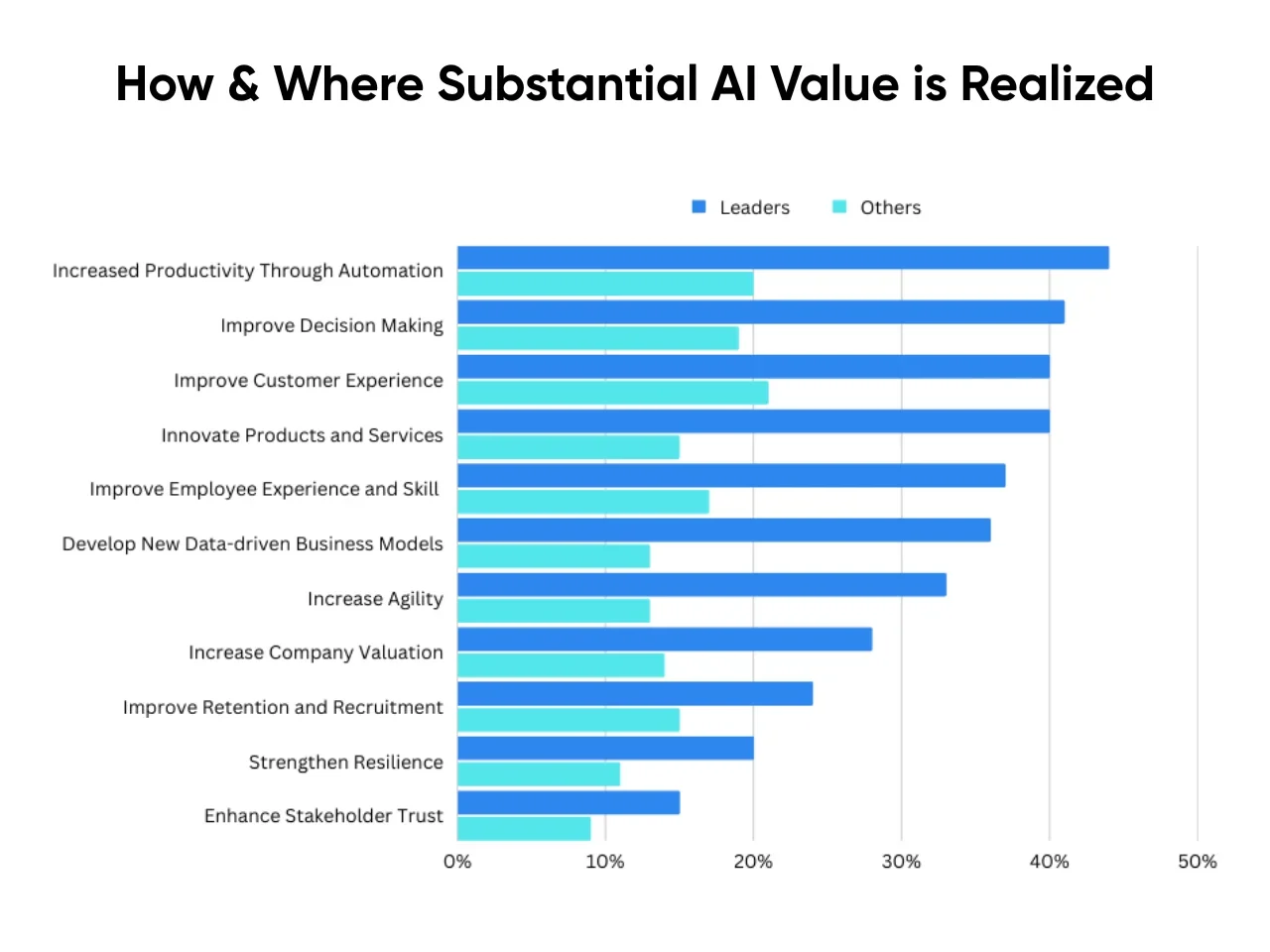
AI-driven analytics also provides real-time insights into targeting potential leads and customers, making marketing campaigns more effective.
10. Learning and Upskilling
In software development, continuous learning and upskilling are crucial. AI-enabled tools empower developers to stay ahead by providing real-time data access for analyzing patterns and customer needs, leading to more effective software solutions. AI-assisted analytics also highlight skill gaps within your team, guiding necessary training.
For example, developers can use OpenAI Codex as a learning tool to refine programming skills and stay current with new technologies, libraries, and frameworks.
Emerging Trends: Agentic AI, Low-Code/No-Code, and Democratization
At the forefront of AI-powered software development are three trends reshaping DevOps as a whole. Let’s take a look at how they’re doing that.
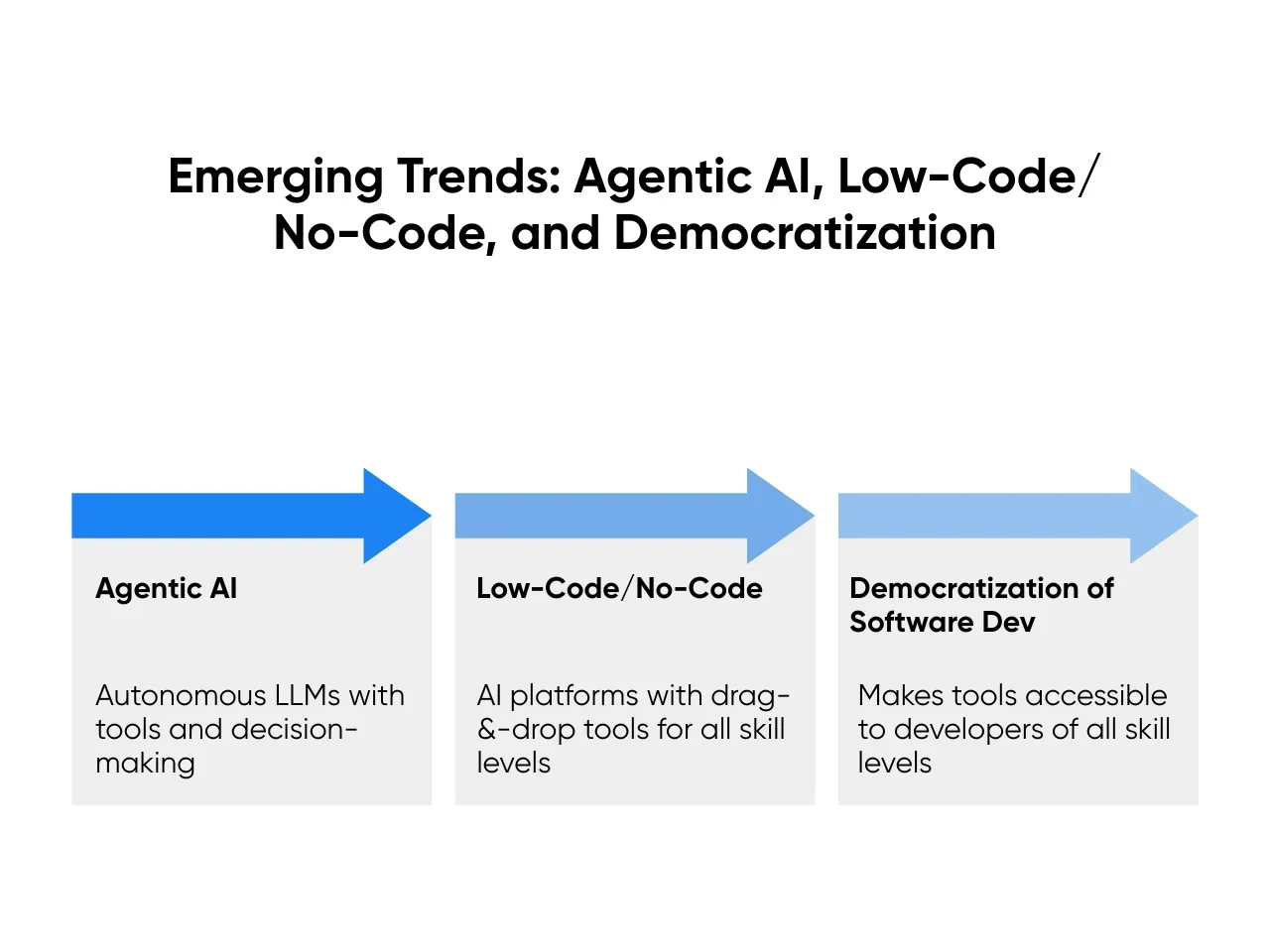
Agentic AI
Agentic AI—also known as autonomous AI agents—blends Large Language Model capabilities with decision-making and tool usage. Unlike generative AI, which passively reacts, agentic systems independently plan, execute multi-step workflows, call external APIs, handle memory, and learn dynamically.
Morgan Stanley’s DevGen.AI is a particularly remarkable example, having processed 9 million lines of old code, saving software engineers 280,000 hours. However, they are still liable to create security vulnerabilities with their tool calls, necessitating human oversight and override capability.
Low-Code/No-Code Platforms
Formerly operating on inflexible pre-built components, these platforms now integrate comprehensive AI-assisted features like intelligent debugging and drag-and-drop AI components, allowing developers of all skill levels to build complex apps with visual scripting.
American research firm Gartner expects that by the end of 2025, 70% of new apps will have been built by LCNC development tools like Bubble or Retool. Although experts have cautioned that this introduces risks involved with fragmented governance, they offer significant time savings.
Democratization of Software Development
Democratization means making more tools available to developers of all skill levels, including citizen developers, which includes things such as low-code/no-code platforms. With the help of AI-powered tools, the role of a developer shifts more towards one of a “builder”, focusing on problem framing, iteration, and impact. This results in more avenues for innovation.
Aloa’s Approach: How We De-Risk and Accelerate AI Adoption for Clients
Consultative Discovery and Vetting
We begin every engagement by understanding each client’s unique business needs and goals. This enables us to design practical, scalable AI solutions that are tailored from the ground up to solve your most pressing operational challenges.
Project Management and Accountability
We start by quickly crafting working prototypes to validate key assumptions, gather user feedback, and ensure that the full-scale product is aligned perfectly with your vision.
Throughout development, we maintain close communication with your team and provide ongoing support to ensure that the tools we build integrate seamlessly with your existing systems and workflows.
With this collaborative and iterative approach, we make the fullest use of resources and ensure transparency at every stage.
Post-Launch Support and Continuous Improvement
After launch, we don’t just disappear. Aloa’s active involvement stays with you well after deployment, continuing our commitment to iterative improvements, knowledge-sharing, and ongoing support to keep your AI solutions effective and current. We believe in proactive optimization, and we ensure it with systematic monitoring, evaluation, and refinement.
Key Takeaway
AI won’t replace your developers, but it will reshape your development workflow. With thoughtful application, AI in software development can accelerate iteration and allow you to focus your top talent on what matters most. As long as you can avoid common pitfalls like misaligned tooling, poor oversight, and over-reliance on raw outputs, AI can be a reliable, strategic advantage rather than additional complexity.
That’s where Aloa comes in. We don’t just add AI to your stack. We integrate it with purpose. We make sure AI adds value, aligning tech seamlessly with your workflow, your product goals, and your team’s strengths. Curious about what that might look like? Let’s talk.
Frequently Asked Questions (FAQs)
How does AI in software engineering boost productivity?
AI automates repetitive tasks (e.g., code formatting, debugging, testing), helps prioritize workflows, and offers real-time code suggestions. This frees up developers to focus on creative work and solving more complex problems. The result is an up to 18% bump in overall productivity in certain areas.
Are there limits to what AI can do in software engineering?
AI tools can struggle with subtle context, critical thinking, bias, and explainability. They can generate faulty or insecure code, so human expertise remains essential
How does low-code/no-code work?
Low-code/no-code (LCNC) involves using visual interfaces and pre-built components to create applications with minimal or no traditional coding. AI enhances this further by translating plain English descriptions into functional code – a process affectionately referred to as “vibe coding”.
What is technical debt, and how does AI help with it?
Technical debt refers to shortcuts or outdated code that complicates future maintenance. AI tools assist by analyzing code quality, suggesting refactors, generating tests, and improving documentation—helping teams proactively reduce debt.
Will AI replace human software engineers?
Unlikely. AI augments human developers and shifts focus to innovation and oversight rather than replacing them. In fact, productivity gains often lead to more engineering roles—not fewer.
How can you measure the efficacy of AI-based software development?
You can measure the actual benefit of integrating AI in software development by tracking KPIs such as time saved, bug reduction, and code quality improvements. Monitor metrics like task completion speed, defect rates, and team satisfaction.
How does AI improve cross-industry capabilities?
AI integration enhances cross-industry capabilities by embedding intelligent automation, data analysis, and decision-making into existing systems and workflows. This allows industries to take advantage of AI capabilities regardless of their technical foundation.

